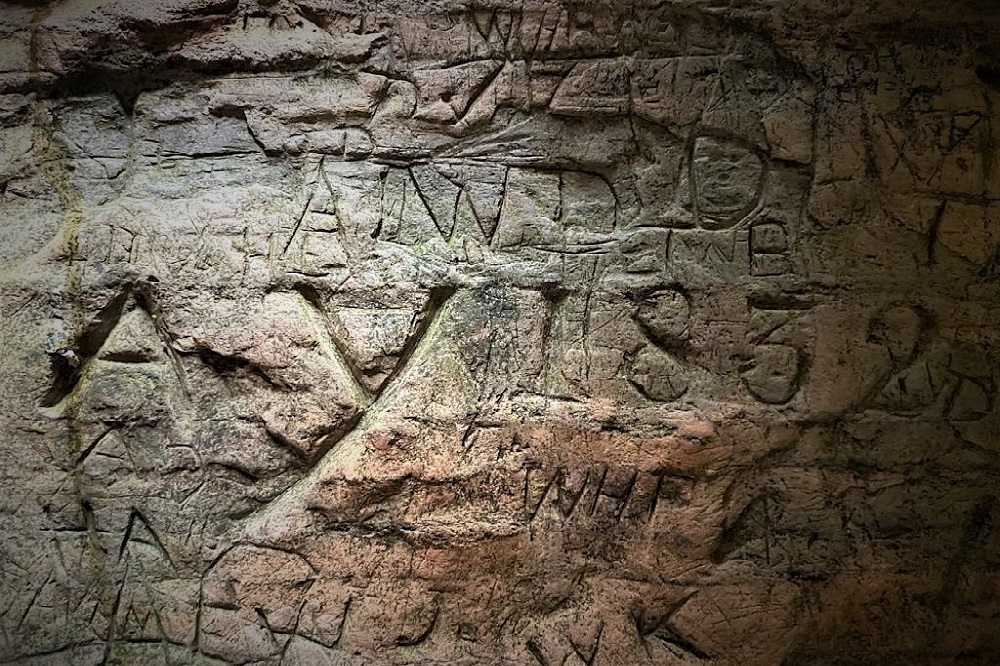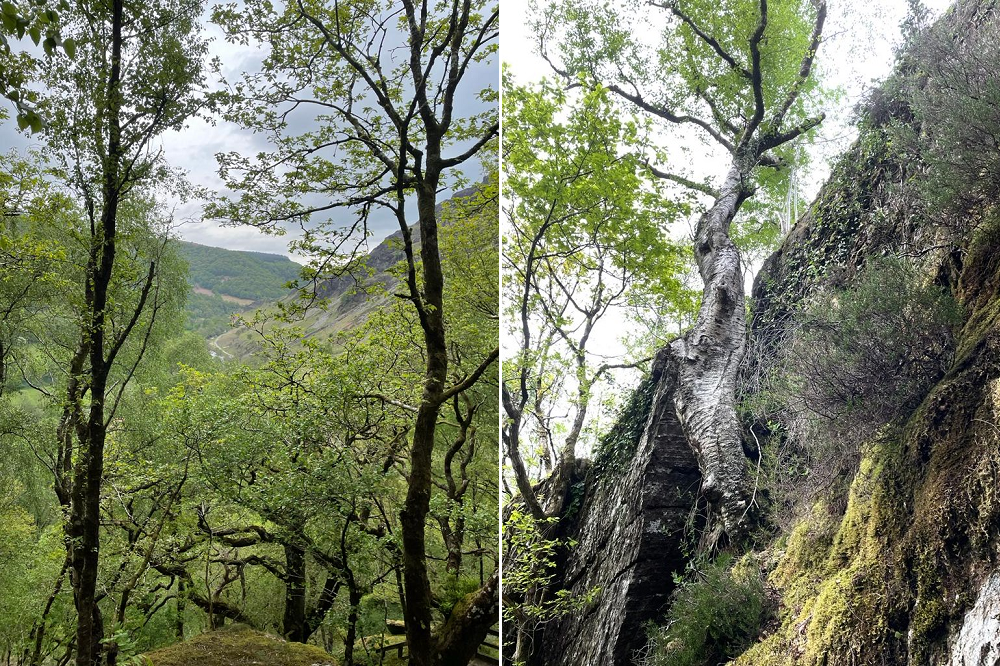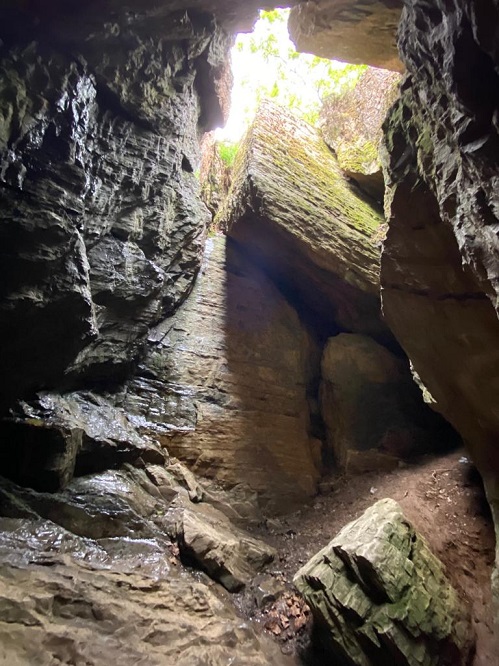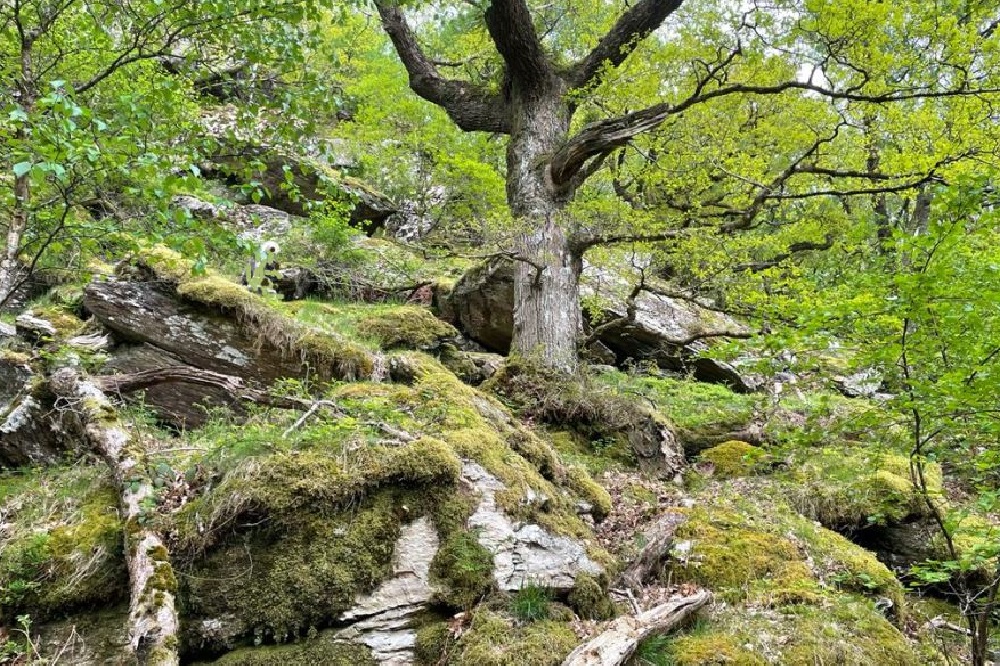Tawny Clark goes on a rainforest adventure to find Twm Sion Cati

Tawny Clark
It’s not every day a family stroll turns into an epic rainforest adventure, yet, deep in the heart of Wales, it seems anything truly is possible.
Today, we somewhat unexpectedly find ourselves on a voyage of discovery, delving into the cavernous depths of Welsh history, and searching high and, well, higher, for the secret haunt of an infamous outlaw.
Having trotted along the boardwalk at RSPB Gwenffrwd-Dinas, and reached the River Tywi, south of Llyn Brianne reservoir, we enter a realm so far removed from the existence we’ve escaped from for the weekend, and so lost in time, that I literally have to pinch myself.
Our pilgrimage through the ice-carved gorge begins with a signpost. It’s engraved with a cantering horse whose rider is clothed in cape and Capotain hat. An evocative image which immediately takes us back five hundred years.
We scramble alongside the rock-plundering river. It’s slippery and my words – the words of mothers everywhere – echo incessantly around the gorge, ‘Be Careful.’
My eyes turn momentarily away from the perilous depths of the tantalising Tywi. And instantly, I’ve stepped through the wardrobe into another world.
A world which seizes hold of me with an iron grip and wrenches me sharply away from any concern I have for the welfare of my adventurous children.
It melts away all the worries I had in the seconds, the minutes, the hours before I arrived here. The second my eyes fall upon this unbelievable spectacle; my mind is inexplicably blank.
Celtic rainforest
This is a Wales I’ve never experienced.
A habitat so out of context, so extraordinary, so mesmerizing that I can do nothing but stare, open-mouthed, overwhelmed, and stunned into silence by the sublimity of this very special place.
This Celtic rainforest.
I have no choice but to stop and gaze in awe at the towering oaks and silver birches, which stretch eternally skyward on the precipitous slope.
Up and up they tower, toward the distant, darkening clouds.
Giant boulders burst from the forest floor and loom ominously above. Jagged edges are smoothed by soft furnishings of liverworts and bryophytes.
They sprawl decadently over the scene like a moss-green, goose-down duvet; a cocoon you could slumber in for a thousand years.
Ancient lichens and epiphytes adorn every aged stem. Every branch, reaching out like bristly, robust forearms, ready to wrap around you and return the bear-hugs you feel compelled to offer every fluffy torso.
Everything drips and oozes with life.
It’s impossible to describe as anything other than a scene stolen from Tolkien. Or perhaps the opposite is true. Either way, this is, undoubtedly, Middle Wales.

Stark contrast
In stark contrast, across the river the mountainside is bare, virtually devoid of trees and scrub. Comparable only in its spattering of rocky crags and boulders.
Loose scree trickles precariously downwards, towards the deep base of the gorge.
My head turns from this more familiar upland landscape, back to the all-consuming, vivacity of the hillside to my left.
The two are polar opposites. It seems impossible. Maybe nature is playing some trick on my mind.
But of course, it’s humans, not nature, who are the landscape architects responsible here, as anywhere.
It’s no accident that the remaining fragments of Celtic rainforest, or Atlantic Oak Woodland, are restricted to steep, inaccessible slopes where vegetation clearance and livestock grazing was too back-breaking an endeavour for the two-legged claimers of all and sundry.
The bare faces of the surrounding peaks, and innumerable hectares of upland conifer plantation beyond, are evidence of our past and present land management practices.

Breathtaking
Beyond this unique realm, the landscape is anything but natural, and so accustomed are we to it, that to step into a place so completely wild, so seemingly untouched by human hand, makes this all the more incomprehensible.
It is, quite simply, breath-taking.
We ascend gradually with the rocky path, away from the continuous cymbal crashes of falling water – the eternal slave to gravity – and venture deeper beneath the rainforest canopy.
The path weaves among the trees. Gently, I glide my fingers across their furry bodies. They tickle my palms in reply.
I peer into the cracks and crevices that conceal precious assemblages of flora, fauna and fungi. I could lose myself forever if I gaze too long.
The sudden appearance of wooden steps returns me rather too abruptly to present day. My glowing heart sinks at the sight of so many. Up and up and up they go, like a game of Tetris gone awry.
I’m grateful for them, insomuch as they lead to our destination. The route to which would otherwise involve a treacherous, foolhardy clamber up innumerable, impassable rockfaces. But still, so many steps.

Lovable rogue
We’re very close. We can’t turn back without completing this climb; it is after all the purpose of our visit. We have come to see Twm Sion Cati’s cave.
Often hailed as the Welsh Robin Hood, I admit that until today, I’d never heard of the notoriously crafty conman, Thomas Jones, known as Twm Sion Cati.
Like Robin Hood, Twm did supposedly rob from the rich. However, the concept of giving to the poor seems to have bypassed this ‘lovable rogue’.
A skilled archer, it’s told that Twm could pin a victim’s cloak to their saddle, leaving them helpless to prevent the robbery, but otherwise unharmed.
Another story tells how Twm outwitted an angry farmer.
Enraged by the theft of a bullock, the farmer left a beggar holding his horse and whip as he entered the house of Twm Sion Cati to confront the likely culprit.
The beggar – Twm himself – mounted the horse and rode to the farmhouse, where he told the farmer’s wife her husband was in serious trouble and needed money in great haste.
Seeing her husband’s horse and whip as proof of Twm Sion’s account, she duly handed over the money.
With coffers full and a fine horse, Twm took off immediately for London.
Legend has it he hid in this cave from the Sheriff of Carmarthen. It’s a hell of a climb. My heart is pounding, my legs are screaming with lactic acid, and my expectation, like the elevation of the cave, is sky high.

Hiding place
I’m sure it was an excellent hiding place – mainly I’d imagine due to its sheer inaccessibility and absence of kerb appeal.
With a narrow, slippery, and sharply inclining entrance, I opt against scrambling the final few metres on hands and knees to get ‘inside’.
There’s no roof and a damp breeze blows down from above. It’s more a pitched cleft in the rockface than a cave really.
My other half is rather more enamoured.
Having crawled up into the ‘cave’, he admires the workmanship of the centuries-old tags chiselled into the rock and spends an inordinate amount of time soaking up the ambiance, and the damp.
And indeed, as is characteristic of this rare and unimaginably wondrous habitat, it begins to rain.
Our already excessively steep and slippery descent to the valley floor is dicier than ever.
As we woefully bid farewell to this wondrous realm and reality resumes, a repetitive chorus resounds through the rainforest, ‘Be Careful!’
You can read more from Tawny Clark here
Support our Nation today
For the price of a cup of coffee a month you can help us create an independent, not-for-profit, national news service for the people of Wales, by the people of Wales.





You paint an evocative picture Tawny. I want to go now too.
You hit on something calling the environment Tolkeinesque, since the great author was inspired by the landscape of Cymru (and Shropshire which is really Cymru too). Tolkien himself mentioned I believe that his Elvish was based on the senior language of these lands.
I really enjoyed reading this account. I am a fairly regular visitor to Gwenfrwdd Dinas and can easily relate to the impression it has made on the author.